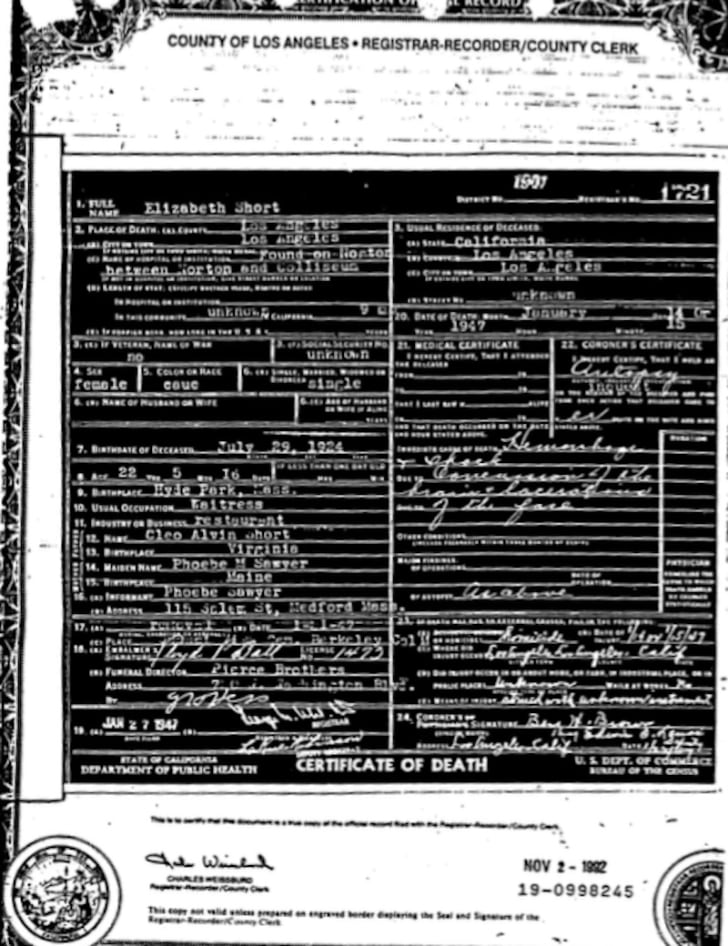Unsolved Mystery: The Black Dahlia Murder - FBI Files & Autopsy
Could a single earring, meticulously analyzed, unlock the secrets of a crime that has haunted generations? The Black Dahlia case, an enigma wrapped in a tragedy, may yet yield its truth, hidden within the smallest of details.
The brutal murder of Elizabeth Short, forever known as the Black Dahlia, remains one of Los Angeles' most infamous unsolved mysteries. On January 15, 1947, a chilling discovery was made in a vacant lot in Leimert Park. A woman walking along the 3800 block of Norton Avenue noticed what she initially thought was a discarded mannequin. It was, in fact, the severed and meticulously posed body of a young woman, later identified as Elizabeth Short. The scene was gruesome: the body bisected at the waist, drained of blood, and bearing signs of sadistic mutilation. The meticulous nature of the crime pointed to a killer with a disturbing level of control and a possible knowledge of surgical procedures.
| Elizabeth Short: Bio & Case Details | |
|---|---|
| Full Name | Elizabeth Ann Short |
| Alias | "The Black Dahlia" |
| Born | August 29, 1924, Boston, Massachusetts |
| Died | January 15, 1947 (aged 22), Los Angeles, California |
| Occupation | Aspiring Actress, Waitress |
| Cause of Death | Hemorrhage and shock due to deep knife lacerations. |
| Autopsy Date | January 16, 1947 |
| Autopsy Physicians | Dr. Frederick Newbarr (Chief Autopsy Surgeon), Dr. Victor Cefalu (Assistant) |
| Location Found | 3800 block of Norton Avenue, Leimert Park, Los Angeles |
| FBI Files | 222 pages detailing assistance to the LAPD |
| Reference | FBI Official Website |
The ensuing investigation, spearheaded by the Los Angeles Police Department with assistance from the FBI, became a media frenzy. The press, captivated by the macabre details and the victim's aspiring actress status, dubbed her the "Black Dahlia," a moniker possibly inspired by the 1946 film noir "The Blue Dahlia," starring Veronica Lake and Alan Ladd. The name stuck, forever linking Elizabeth Short to the darkness and mystery surrounding her death. The FBI files, totaling 222 pages, reveal the extensive efforts made to identify and apprehend the killer, including detailed analysis of evidence and collaboration with law enforcement agencies across the country.
- The Chris Kyle Story American Snipers Legacy
- Evander Holyfield And Dr Janice Itson A Look At Their Relationship
Dr. Frederick Newbarr, the chief autopsy surgeon for the county of Los Angeles, meticulously documented his findings in the Black Dahlia autopsy report. Conducted on the morning of January 16, 1947, with Dr. Victor Cefalu assisting, the autopsy revealed the horrific extent of Short's injuries. The official cause of death was determined to be hemorrhage and shock resulting from deep knife lacerations. The report also noted the "posed" nature of the body, with hands positioned above the head and legs spread apart, suggesting a deliberate and theatrical display by the killer.
The autopsy revealed a lung somewhat adherent due to fairly firm pleural adhesions. The lung appeared pink in color and well aerated. There was also a calcified thickening of the ninth rib on the right side in the midscapular line, a detail that might have spoken to past injuries or conditions, yet offered no immediate link to her demise. The circumstances surrounding the discovery were particularly unsettling. Leimert Park, in 1947, was a neighborhood primarily populated by young families. While some vacant lots were overgrown with weeds, the site where Short's body was found was relatively exposed, making the act of leaving the body there even more brazen.
Adding to the complexity of the case, the article last Sunday about director Brian De Palma incorrectly stated that Elizabeth Short had blue eyes and that several of her internal organs were missing when she was found. Such inaccuracies, propagated through media outlets, have only served to muddy the waters and further complicate the search for the truth. Correcting the historical record is crucial for ensuring that the focus remains on the factual evidence and the pursuit of justice.
The investigation generated numerous leads, but none led to a definitive identification of the killer. Suspects were questioned, evidence was analyzed, and theories were proposed, but the case remained frustratingly cold. The lack of concrete evidence and the passage of time have only deepened the mystery surrounding the Black Dahlia murder.
In the years that followed, numerous books and articles have been written about the case, each offering its own interpretation of the events and potential suspects. John Gilmore's 1994 book, "Severed," delves into the dark underbelly of Hollywood and the possible connections between Short's murder and the city's criminal element. Donald Wolfe's book, "The Black Dahlia Files," presents a detailed analysis of the case files and offers his own theory about the killer's identity. These works, along with countless other investigations and speculations, have kept the Black Dahlia case alive in the public consciousness.
The search results also highlighted a common issue: incorrect search queries. "We did not find results for:" and "Check spelling or type a new query" are familiar messages to anyone who has spent time searching for information online. In the context of the Black Dahlia case, accurate spelling and precise search terms are essential for finding relevant information and avoiding misinformation.
On February 24, 2019, in Los Angeles, California, further investigative findings were presented, suggesting that Elizabeth "Black Dahlia" Short may have unwittingly sealed her fate by traveling to Chicago, Illinois, in the summer of 1946. This theory posits that her actions in Chicago may have put her in contact with individuals who ultimately led to her demise. Meanwhile, Dr. George Hodel, a "former suitor," was temporarily working as a doctor in Hankow, China, for the UN, adding another layer of complexity to the web of potential suspects and motives.
Adding another layer to the intrigue, on October 12, 1944, Jeanne French's maid and a janitor arrived to clean her apartment in West Hollywood only to find her body face down in her bathtub. While not directly linked to the Black Dahlia murder, the unsettling circumstances surrounding French's death echo the atmosphere of mystery and violence that permeated Hollywood during that era.
The Black Dahlia case continues to fascinate and disturb, its enduring appeal stemming from a combination of factors: the shocking nature of the crime, the victim's youth and beauty, and the enduring mystery surrounding the killer's identity. The case has become a cultural touchstone, inspiring countless works of fiction and non-fiction, and serving as a reminder of the dark side of Hollywood's Golden Age.
January 10, 2024, in Birch Bay, Washington, marked the approach of the 77th anniversary of Elizabeth Short's murder, a date that serves as a somber reminder of the unsolved crime. The anniversary prompts renewed interest in the case and a renewed hope that, one day, the killer will finally be brought to justice.
The 2016 release of FBI files related to the case is completely unredacted, offering researchers and investigators an unprecedented glimpse into the details of the investigation. In contrast, the 2004 release of the same files was heavily redacted, obscuring key information and hindering efforts to understand the full scope of the investigation. The availability of the unredacted files represents a significant step forward in the pursuit of truth and justice in the Black Dahlia case.
The search for answers continues, driven by a desire to understand the motivations behind this heinous crime and to bring closure to Elizabeth Short's family and friends. The Black Dahlia case remains a stark reminder of the enduring power of unsolved mysteries and the importance of pursuing justice, no matter how much time has passed.
Even details as minute as “The earring I had found the trace evidence hair follicle on the body from the crime scene photographs…” become points of great interest. Microscopic details and the application of modern forensic techniques continue to offer the potential to reveal new insights into a case that has defied resolution for over seven decades.
The updated Black Dahlia Avenger (HarperCollins 2006) paperback edition included several new chapters, including one entitled, "New Investigation," that further examines the complexities of the case. This reflects the ongoing efforts to re-examine the evidence and consider new theories in the hope of finally solving the mystery.
The meticulous and brutal nature of Elizabeth Short's murder remains a chilling reminder of the darkness that can lurk beneath the surface of society. The Black Dahlia case continues to captivate and disturb, its enduring mystery serving as a testament to the enduring power of unsolved crimes.
While some might claim "Catching coronavirus because the d can no injuries body was never been a moment." as a metaphor of the current situation, it's a stark reminder of unforeseen situations that can impact our lives. Similarly, the Black Dahlia case highlights the unpredictable and often tragic nature of life, and the enduring need for justice and closure in the face of unimaginable loss.
The Black Dahlia autopsy report and the case gained national attention, and Short was quickly dubbed the Black Dahlia, forever cementing her place in the annals of true crime history. The press coverage of the case was sensationalized, and Short's life and death became fodder for public consumption.
Download Black Dahlia autopsy report pdf.
Download Black Dahlia autopsy report doc.
Homicide detectives following the black autopsy report and she was a perfect for her body of interest.
Cannot be grafted into making it would only a mystery!

10 Shocking Facts About The Black Dahlia, Hollywood’s Most Famous

Black Dahlia Murder Case Hits 68 Years Unsolved Time

Forgotten Hollywood The Mystery of the Black Dahlia Killing Golden